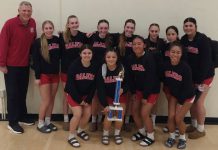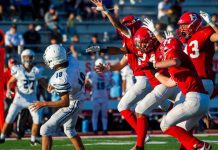There is no better descriptor for San Juan Bautista than
”
crossroads.
”
Long before humans settled in this locale and named it San Juan,
the earth’s geologic processes deemed it a crossroads.
There is no better descriptor for San Juan Bautista than “crossroads.” Long before humans settled in this locale and named it San Juan, the earth’s geologic processes deemed it a crossroads. The North American and Pacific tectonic plates meet right here along the Mission’s backyard to form the San Andreas Fault. Another stunning example of San Juan Bautista’s crossroads qualities lies in its cultural history. A great place to explore this history is San Juan Bautista State Historic Park.
To begin, stroll the Plaza along the west side adjacent Mission San Juan Bautista out to the northern edge. Peer down the escarpment at the San Juan Valley below. Notice you are on quite a bit of a rise or plateau. Here, you stand on the Pacific Plate, and below you to the northeast is the North American Plate. Depending on your timing, it could be an earthshaking view.
If you are early, watch the sun rise over the Gavilan Mountains and shed its first light onto the fertile farm fields which now take the place of the natural marshland of centuries past. If you are not an early riser, catch the sun to the west casting its golden glow against the buildings before it dips down below the Coastal Range.
Take a moment to imagine what the landscape looked like for the area’s Native American inhabitants, the Mutsun people. You might visualize a valley covered in one or two inches of water, abundant tule grasses, large flocks of waterfowl darkening the sky, deer and antelope roaming the foothills, and perhaps a grizzly bear or two. This was also likely the scene encountered by the De Anza Expedition, traveling the area in 1775-1776 under the Spanish flag.
From this vantage, you may also view a spur of one of California’s oldest and most famous roads, the El Camino Real. The Spanish missionaries used this route to travel from mission to mission, creating a network of missions one day’s walk from one another. To close the gap between two already established missions, Mission San Carlos (Carmel) and Mission Santa Clara, they traveled a half mile from the El Camino Real searching for a prime spot to build a new mission. When they reached this locale, they found an established Native American population, an adequate food and water supply, and building materials such as wood and limestone nearby.
The location had all the makings of a successful mission and, thus, Mission San Juan Bautista was founded on June 24, 1797.
When you turn and look inward at the Plaza from the north, you will notice five prominent structures, all of which exemplify the crossing of cultures and historic periods that has occurred in San Juan.
Immediately recognizable to your right (west) is Mission San Juan Bautista, with its imposing bell tower, Spanish arcade (arches), tile roof, and its adobe walls built from the sweat and toil of native hands. Do not, however, limit your concept of the Mission to this single building.
In its hey-day, Mission San Juan Bautista was comprised of over 100 buildings of varying size and function, only a few of which are in evidence today.
One of these is the building directly in front of you (south), now called the Plaza Hotel. This structure appeared very different in 1813 when it was completed as a Spanish soldiers’ barracks. It was a simple, one-story adobe equipped with a guard tower on the east end. Today, the Plaza Hotel represents the early American period in California, when San Juan prospered as a stagecoach stop and center for trade.
The Hotel was a haven for weary travelers to brush off the dust, get a night’s rest, eat a savory meal in its popular restaurant, and rejuvenate in its lively bar room before heading back out on the road.
Adjacent the Plaza Hotel on the southeast corner of the Plaza sits the Castro Breen Adobe, representing the transition from religious to secular control of the missions and the subsequent change from Mexican to American rule in California.
Built as a Mexican government headquarters in 1840-41 by Indian laborers under the supervision of Jose Tiburcio Castro, the building was sold in late 1848 to the Breen family, who survived the Donner Party journey and became prominent members of the local community.
Looking to the east side of the Plaza at the Plaza Hall or Zanetta House, you see yet another fine example of time periods and cultures brought together.
The first use of this structure was as a barracks for Mission Indian women in the 1830s. Salvaging what he could of the original adobe, the owner of the Plaza Hotel, Angelo Zanetta, and his business partner John Comfort, built what they hoped would be the county courthouse of the newly established San Benito County in the late 1860s.
When this plan fell through and Hollister was selected as the county seat in the early 1870s, Zanetta modified the building into a residence for his family downstairs and a public meeting and celebration hall upstairs.
Last, but certainly not least, your eyes meet with the stately Plaza Stables adjacent Plaza Hall. 1861 is the most agreed upon year for the construction of the stables. This was a much-needed addition to the Plaza, as it was a busy stage and wagon stop where travelers needed to feed and water their horses, and pay a visit to the blacksmith to have equipment repaired.
You could even rent a horse and carriage from the Stable if you did not have your own, and if you could not afford a room at the hotel, you might have asked to rent a place in the hay loft for a night’s rest.
By simply standing in this one spot outside at San Juan Bautista State Historic Park and taking in the 360-degree panorama, you can witness a magnificent landscape and the meeting place of several different cultures, from the Mutsun people and the Spanish Missionaries, to the Mexican Californios and the eclectic group of early “Americans.”
There’s much more to discover when you venture inside the park’s buildings and gardens, and along the sidewalks of this quaint historic town.
So, come out and further explore this cultural crossroads at one of your local California State Parks.
Ranger Andrea Mapes has been a State Park Peace Officer assigned to San Juan Bautista SHP and Fremont Peak SP for two years. Contact her by e-mail at am****@******ca.gov.









